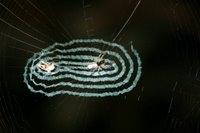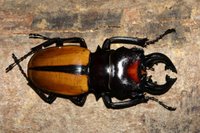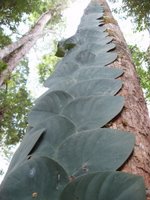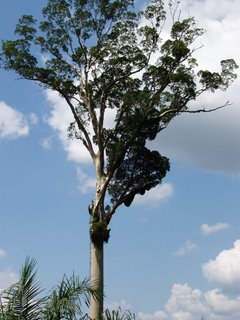 There was a pix in the newspaper today of a very large millipede which apparently caused a ruckus in a town market. The millipede was 8″‘ long – nothing unusual. I see them all the time in the forest. Along with some of the other things I’ve posted here. What worries is that it should cause a stir.
There was a pix in the newspaper today of a very large millipede which apparently caused a ruckus in a town market. The millipede was 8″‘ long – nothing unusual. I see them all the time in the forest. Along with some of the other things I’ve posted here. What worries is that it should cause a stir.
We have become so divorced from the natural world – of which we are an integral part – that we think ourselves somehow special and able to exist apart. We surround ourselves by things that are both tamed and exotic – plants, animals – because we prefer them to what we already had. We destroy everything that bothers us – snakes, wasps, spiders, tigers, elephants, rainforest…what does it matter? We can survive without them.
to exist apart. We surround ourselves by things that are both tamed and exotic – plants, animals – because we prefer them to what we already had. We destroy everything that bothers us – snakes, wasps, spiders, tigers, elephants, rainforest…what does it matter? We can survive without them.
Can we? I’ll make a prediction. If you are under 30 years old now, and live to be 80 plus, you’ll find out in your lifetime that we can’t. At least not with the kind of life you have now. And I don’t mean it will be better. It won’t.
 Not so very many years ago, farmers and villagers over Malaysia counted the seasons by the arrival and departure of migratory birds. (Well, what better way when we don’t have winter and spring and autumn and it’s kind of summery all year long?) Now, when I mention bird migration, people look at me and say, surprised, “We got migratory birds, what?”
Not so very many years ago, farmers and villagers over Malaysia counted the seasons by the arrival and departure of migratory birds. (Well, what better way when we don’t have winter and spring and autumn and it’s kind of summery all year long?) Now, when I mention bird migration, people look at me and say, surprised, “We got migratory birds, what?”
I have to explain migration to people suddenly worried about bird flu. I have to tell them the most elementary of things – yes, migration happens. Yes, birds do come from Indonesia to here. If you ever bothered to look, you’d see them. No, you probably won’t catch flu that way – you’ll get it via some idiot who imports illegal fighting cocks, or who smuggles in exotic pet birds for his shop.
 We ignore our connection to the natural world at our peril. Bird flu could be the next wake-up call. And if it is, it will be because of the way we farm and the way we market our food. It will be because we have made too many inroads into the wild, not because the wild has come looking for us.
We ignore our connection to the natural world at our peril. Bird flu could be the next wake-up call. And if it is, it will be because of the way we farm and the way we market our food. It will be because we have made too many inroads into the wild, not because the wild has come looking for us.
Want to learn about our wild heritage and do something to save yourself? Join the Malaysian Nature Society. And stay a member for the rest of your life. They at least are trying – on your behalf. And yet they have a measly 3,000 or so members in a population of 23 million. And that – to me – is a national disgrace.
Photos [courtesy my husband]
Beetle, spider and vine from Maliau Basin
tualang tree [Koompassia excelsa] with wild bee nests hanging under the branches, oil palm plantation, Kalabakan. The world’s tallest tropical rainforest tree.

Hello, I stumbled over your blog somehow, and I’m enjoying it thoroughly. And, you look really cute in your picture!
Speaking of birds and enjoying one’s natural surroundings, I was wondering, since you seem to be knowledgable about birds here in Malaysia–a bonafide ornithologist in fact–if you can please tell me the name of the bird that has a very distinctive song, a “whoop, whoop, whoop, whoop,” with five to seven whoops in fast succession. I keep looking up at trees to try and identify it, but it’s a secretive bird, difficult to spot. Someone told me that it’s a very plain black bird. It’s also a pretty common bird, I think, in Penang at least! I’m sure most people know it or at least recognize its song.
The other distinctive song I hear is from another bird (or the same bird?) with a mournful “whoo, whoo” coo that sounds two times in succession and then repeats. I have no idea what that one looks like.
I’m sorry to trouble you, Ms. Larke, but I would be so happy to learn the names of these two birds finally! I looked for a Birds of Malaysia book at the bookstore recently and there wasn’t one. If I ever do find such a book, and I at least know the names of the birds, then I can look them up to see what they look like.
Whoop, whoop!
Hi Lily – welcome to my blog.
I think the bird you are talking about is a Koel (Ko-el, Ko-el, hence the name. At times it also gives the repeated whoop call you mention.). It’s a large black bird like a crow, but has a long tail and pale beak; the female has brown and black patterning. They are a species of cuckoo, and lay their eggs in the nest of crows.
I think you often see it, but just assume it is a crow! (look for a “crow” with a long tail).
If you are really interested in birds, try joining MNS – the chairman of Penang branch, Kanda Kumar is a lovely man and a birdwatcher, an old friend of mine.
There are some Malaysian bird books around. Some on sale at the MNS office in KL – not sure about Penang. Go to the link on this post…
P.S. I’m not really cute…marvellous what photoshop can do with photos :-)…
Hello Ms. Larke,
I’m so happy that you were able to recognize the bird from my attempt at describing its song in words. You made my morning. The koel, ah? Two songs, one bird, is it then? I went to go find a photo of it online and found one here:
http://www.orientalbirdimages.org/birdimages.php?action=birdspecies&Bird_ID=425&Bird_Image_ID=678&PHPSESSID=5c556f94d1
Looking good? The one time I THOUGHT I had spotted the bird singing that song, indeed, it had that spooky-looking bright red eye. I checked with a Malaysian friend of mine at lunch today, and he agrees with you. I asked him if he’d ever heard the name “koel” for a bird, and he said, mmm, maybe, yes, that sounds right. Then, I asked don’t they teach Malaysians in school about their own natural environment? Don’t they have ecology courses or anything on local flora and fauna? No, nothing. He wasn’t much of a student, though, so maybe he wasn’t paying attention in biology class! And, hopefully younger generations of students have been exposed to environmental subjects in school. If students were taught from an early age to appreciate the nature that’s still left, maybe the Malaysian Nature Society would have tons of supporters! (Thanks for the reference to MNS.)
And, thank you, Ms. Larke, for taking the trouble of identifying my favorite bird. Too bad it’s so creepy looking!
P.S. Nah, I can’t believe it’s just the Photoshop! 😉
🙂